The organist-composer Jeanne Demessieux (1921-68) is best remembered as a virtuoso performer in the French symphonic tradition, and the composer of major organ works that are unusually demanding, both technically and intellectually.1 Yet, Demessieux is also virtually the only composer to have published a set of short and technically easy pieces for organ in the French post-romantic style. Written in 1947, specifically for publication in the United States, the work is entitled Twelve Choral Preludes on Gregorian Chant Themes.2 In the words of her biographer, the pieces are:
Preludes on Gregorian themes, intended for student organists who desire to play, apart from the traditional instructional repertoire, contemporary works that, while initiating them in the language of their time, do not impose the extraordinary difficulties of the present-day repertoire.3
During her American recital tours of the 1950s, Demessieux's programs occasionally included one or the other of her favourites from among the twelve pieces.4 In a review of a 1958 recital, Ronald Arnatt refers to these as "finely wrought pieces showing a combination of contrapuntal mastery and lyrical warmth."5 But it was not only in the country of publication that the Twelve Choral Preludes on Gregorian Chant Themes were appreciated. In the late 1970s, a French music critic wrote:
The twelve Chorale Preludes of Jeanne Demessieux are the Catholic Orgelbüchlein of our century. We could all learn something from this masterwork, not only techniques such as concern the treatment of a Gregorian theme, but a religious and liturgical viewpoint.6
The similarity of Demessieux's Twelve Preludes to Bach's Orgelbüchlein lies first in its ordering of the chant-based pieces according to the liturgical year, with preludes on non-seasonal chants occurring last (see Fig. 1).
Figure 1: Titles and genres of the Twelve, with liturgical sources of their plainchant themes.
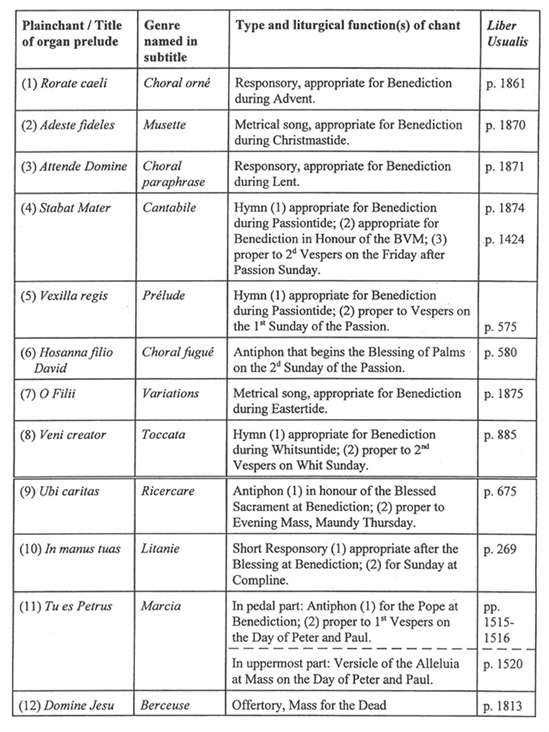
Like the individual organ chorales in Bach's cycle for the liturgical year, Demessieux's settings of plainchant melodies are concise (most are two or three pages in length) and illustrate a variety of forms, procedures, textures, and genres cultivated by liturgical organists, in France in this case. A further and distinctive unifying feature of Demessieux's short set is that the liturgical melodies are largely selected from among the optional and seasonal Latin chants appropriately sung at Benediction7 (the two exceptions are the antiphon Hosanna filio David for the Passion Sunday Procession with Palms, and Domine Jesu from the Mass for the Dead). As may be seen from Fig. 1, column 3, most of the chants appropriate to Benediction are also proper to other rites, such as Vespers or Mass, on particular occasions.
This article will discuss present-day use of the twelve short pieces as repertoire and study material for student organists, focussing first on organ technique and, following that, on historical and theoretical understandings of the pieces as a guide to their interpretation and to their use as models for improvisation and composition of organ music.
Organ Technique
In contrast to the large organs necessary for realization of most of the twentieth-century French repertoire, any of these short pieces may be played on a modestly appointed instrument. Two manuals (the secondary one enclosed in a Swell box), pedal extending to F4, and couplers between the three divisions are sufficient. Registrations, which are specified in English in the score (except when the foreign-language term is the only term for a stop), ask for foundations, mixtures, and solo stops, particularly reeds. The technical demands of the pieces are circumscribed in two obvious ways. Tempi, which are clarified by conservative metronome marks, range from Adagio to Allegretto, with the majority of the pieces being slow.8 Every piece includes pedal, but these parts range from easy to very easy.
Just as importantly, the pieces provide modest technical challenges. With respect to manual technique, it is assumed that the student has undertaken some piano study, and is therefore secure in fluid scales (O filii), leaps (O filii, Veni creator, and Ubi caritas), and large chords that span up to a ninth (Tu es Petrus). The student is ready to begin work on any of the pieces when the basics of manual technique particular to the organ are secure enough to be coordinated with playing easy pedal passages. Manual parts, many of which necessitate reading numerous accidentals, require modern legato and over-legato techniques and, therefore, careful working-out of fingering and finger substitution. Some pieces ask for different but simultaneous articulations in one hand (e.g., Vexilla regis, which has the cantus at the top of the left hand). Indications of manual and registration changes occur where they are most practical (as in Domine Jesu at m. 21), and occasional signs for opening and closing the Swell box do not directly interfere with right-foot pedaling (as in Stabat Mater, mm. 4-5, 24-25). In addition to pedal points, alternation of left and right toes, and easy use of the heel, two pieces contain some easy double pedal, and the more showy pieces use Demessieux's trademark pedal motif, a repeated bounce between a low and a high pitch. In two pieces, the cantus firmus is assigned to pedal. In one of these, Ubi caritas, the cantus consists largely of repeated pitches and stepwise motion in a small range, but the arrangement further stretches the student's ability by placing the chant in both the C3-F3 and C4-F4 pedal registers. The cantus firmus of Hosanna filio David, perhaps the most challenging part for the feet, is supplied with pedalling marks. Although manual and pedal parts vary in difficulty from piece to piece, each prelude requires that the student carefully work out the coordination of attacks and releases by hands and feet.
Students who perfect the technical execution of these short pieces will be also be introduced to the expressive requirements of the French post-romantic idiom, largely a function of its coloristic timbres, harmonies, and textures, and its innovative rhythms. In each piece, the given registration is matched to a characteristic compositional texture and style—e.g., tutti for a chordal march marked ff; full to mixtures for a toccata; foundations on all divisions, coupled, for a passage in rich, five-part texture; a trio of clarinet 8', trompette 8', and flutes 8', 4' for a neo-French-classical variation; cornet for an ornamented melody accompanied by manual and pedal bourdons. By paying attention to these associations, the student can learn to match the registration of other such pieces with their characters and, just as importantly, adopt the style of articulation appropriate to that registration.
Although the score's specific registrations were chosen with the North American, eclectic instrument in mind, they must still be considered a compromise. This is because, despite twentieth-century trends in French organ building, Demessieux's personal preference for performing modern organ music was a tonally unaltered Cavaillé-Coll instrument.9 With the help of recordings of preserved Cavaillé-Coll organs, the student will discover where it is necessary to adapt the indicated registrations in order to come as close as possible to the intended expressive qualities. One is likely, of course, to need the advantage of a fairly large North American instrument in order to do this: discover how to create an approximation of the broad, warm sound of foundations 8' or 8' and 4';10 choose reeds that are suitable in a chorus, or a solo reed appropriate to the character of a piece; find mixture stops that are discrete; and substitute one comparable stop for another in order to create the equilibrium that is naturally possible on a Cavaillé-Coll organ. In making these decisions, it is always important to consider what role the indicated registration plays in projecting a particular mood or idea, whether associated with the musical genre, or with the text of the chant.11 The text associations of Demessieux's registrations will be discussed below in connection with individual pieces.
Beyond the working out of technique and registration, an asset to seeking a piece's most effective interpretation is careful study of its rhythmic and harmonic style. Any of these pieces is short enough for the student to be able to carry out such study. Familiarity with the melodic and harmonic dissonances characteristic of the French style will influence decisions about articulation and the appropriateness of either tempo rubato or strict tempo. Students will learn to express the mood of particular harmonic idioms, such as the ingratiating added-sixth chords and the sudden, distant modulations in Hosanna filio David and Veni creator; the non-functional tertian harmonies of Vexilla regis and Ubi caritas; change of modality in O filii; coloristic, non-tertian harmonies in Stabat Mater; and Demessieux's own, bittersweet harmonic idiom in Rorate caeli and Domine Jesu.
Some of the preludes introduce rhythmic and metric devices not often found in repertoire suitable for students. Adeste fideles contains a precipitous change of beat division from duple to triple at the beginning of m. 35 that should be executed without alteration of the tempo underlying the beginning of a simultaneous rallentando. In Stabat Mater, the quiet right-hand and pedal accompaniment moves habitually on the off-beat, creating an additional challenge to coordination of the hands and feet. The meno mosso variation in O filii features metric shift, which can only be performed convincingly if one understands how and why the points of abrupt metric disturbance are created. Metrical dissonance in this variations set as it relates to the poem O filii will be discussed in detail in a later section.
Creation and Interpretation: Historical and Analytical Issues in the Twelve
The work as a whole illustrates a variety of genres, procedures, and forms for either improvisation or composition of a short piece incorporating a liturgical melody. Understanding of these is essential to the pieces' interpretation. Some of the Twelve represent traditional French genres and procedures for creating a plainchant verset. Others illustrate methods and textures that French-romantic composers derived from German organ chorales, particularly Bach's. Demessieux would have learned improvisational forms from both origins in her studies with Marcel Dupré.12
Some brief, introductory observations on the treatment of plainchant in the Twelve. Probably for the sake of easy comprehension of the chant basis of a piece, the compositional methods Demessieux employs here are those that allow for inclusion of a fairly straight-forward presentation of the pitches of the liturgical theme or, in the case of a very long, through-composed chant, of its most characteristic portion. When the procedure for presenting the given melody derives from early music, Demessieux has updated it in two ways. First, unlike use of a stereotypical, even- and long-note cantus firmus, the plainchant treatments in these organ pieces reflect awareness of the subtlety of chant rhythm promulgated in the late nineteenth century by the Benedictine monks of Solesmes. Second, the style of pitch organization throughout the Twelve is neither modal nor tonal. As already mentioned, their harmonic idiom includes twentieth-century chord types, non-functional chord successions, dissonant counterpoint, and non-tonal means of establishing a pitch centre. Only Hosanna filio David and O filii establish a pitch centre at the opening by means of tonic and dominant harmonies, and only O filii and Veni creator end with a structural progression consisting of literal dominant to tonic harmonies (it will be demonstrated below that the authentic progression near the end of O filii has a programmatic purpose). Pitch organization in the remaining pieces is predominantly centric rather than tonal. That is, listener sense of a key pitch is created not by functional harmonic progressions but by pedal points, emphasis on a pitch or triad by means of repetition or registral placement, and chromatic voice leading into a final tonic triad. In short, although the genres of plainchant treatment represented in this collection derive from pre-twentieth-century organ music, the rhythmic and harmonic styles are post-tonal.
Two pieces in genres reminiscent of early music will be discussed first, beginning with Ubi caritas. Its subtitle, ricercare, is an allusion to a type of hymn verset found in the earliest published French organ work that names its composer, Hymnes de l'Eglise pour toucher sur l'orgue, avec les fugues et recherches sur leur plain-chant by Jehan Titelouze (c.1563-1633).13 Titelouze began each set of hymn versets with a piece he called recherche—the French equivalent of ricercare (meaning "to search"). The genre referred to here is not the fugal ricercar, but its predecessor, a preludial piece improvised in a rhapsodic manner so as to suggest that the player is searching for the mode of the piece being introduced. Titelouze's ricercare incorporate the hymn melody in conservative fashion: while freely imitative polyphony (sometimes based on the chant incipit) is played in the upper parts, the cantus firmus is sounded in the lowest part (possibly intended for a pedal reed), its successive pitches without interruption, in long, even durations.
Similarly, Demessieux's ricercar has the cantus firmus played by pedal and distinguished by rhythmic values that are longer than those in the other parts. In other ways, though, Ubi caritas remakes Titelouze's genre. First, it incorporates a degree of rhythmic differentiation within the cantus that is generally in keeping with the inflections in the chant notation. Second, the primary interest, even so, is not in the familiar melody, for it is assigned to a 4' pedal flute whose pitches fall in the midst of the manual parts.14 The principal means of expression lies, rather, in the manual parts, which search through richly chromatic, arpeggiated chords. When first approaching this piece, one needs to listen carefully to these chords, deciding which pitches are dissonances and what are their (often only implied) resolutions, so as to guide decisions about the shaping of individual phrases and groups of phrases. Demessieux may have felt that Ubi caritas was representative of some of the best in her compositional style, or of the Twelve as a whole, for she included it in some programs of her 1955 American recital tour.15
The other piece representative of early organ music is the choral fugué based on Hosanna filio David. The chant's first phrase, which begins with an upward fifth leap, makes it, alone, an ideal fugal subject. But the most notable feature of this organ setting is continuous presentation of the entire chant (five phrases) in majestic, long-note rhythm, on a pedal 4' clarion—a timbre in keeping with allusions to Jesus's royalty in the Palm Sunday Gospel reading. By containing a continuous, long-note cantus firmus for pedal, this piece, too, is reminiscent of Titelouze's recherches. At the same time, the piece's five-part texture recalls just as clearly the five-part fugues of the later seventeenth-century French composer Nicolas de Grigny, from whom Bach drew inspiration.16 Dupré, in his Cours Complet d'Improvisation, traces the genre back to the sixteenth-century motet, and describes it thus: "each motive of the [chorale] in succession becomes the subject of a little fugal exposition that prepares an entrance of the same motive in augmentation."17
As shown in Fig. 2, Demessieux's Hosanna filio David contains five, short fugal expositions, corresponding to five chant phrases, each exposition containing four manual entries and a pedal solo reed entry.
Figure 2. Five short fugal expositions of Hosanna filio David: relationship to chant phrases, order of entries and tonal contexts of entries.
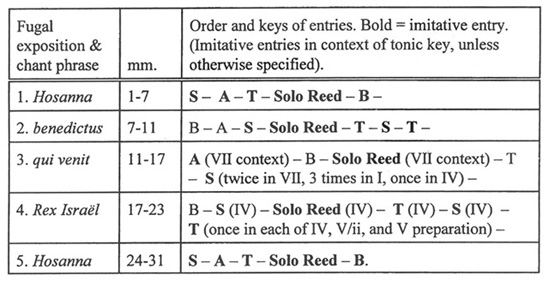
In keeping with the small scale and undemanding nature of Demessieux's Twelve, each exposition does not necessarily contain five imitative entries. Two other idiosyncrasies account for why the phrases played by solo reed, although part of the imitative texture, occur continuously, as in the manner of a recherche by Titelouze. First, the pedal entrance of each exposition, in rhythmic values four times those of the manual entrances, is not always the last to enter. Second, following an early pedal entrance, many manual entrances consist of little more than the incipit of the chant phrase.
Two of the generic designations among the Twelve are puzzling unless one understands them as allusions to particular French organ works of the nineteenth century. One such prelude, subtitled Cantabile, is based on the simple tone for Stabat Mater, shown in Ex. 1a.
Example 1a. Plainchant hymn, Stabat Mater.

Although the chant melody in the organ prelude is marked cantabile, this quality is not the prelude's most salient characteristic; foremost are the affective features that make the piece evocative of the grief of Jesus's mother (see Ex. 1b).
Example 1b. Opening of Demessieux's Stabat Mater.
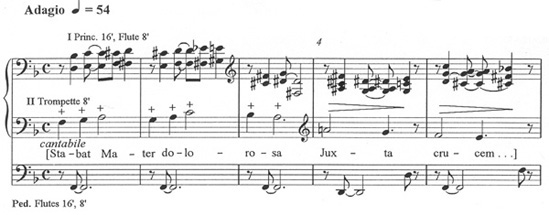
Example 1b, and all excerpts by Demessieux, from Twelve Choral Preludes on Gregorian Chant Themes, by Jeanne Demessieux. © 1950 (Renewed) by Summy-Birchard Music, A Division of Summy-Birchard Inc. All Rights Reserved. Used by permission. Warner Bros. Publications U.S. Inc., Miami, FL 33014.
The harmonies are highly chromatic and their voice-leading is characterized by chains of rising syncopes.18 Other affective features are the rhythmic motives applied to the melody, which include a halting, short-short-long rhythm, heard twice in the ascending melodic stretch (mm. 1-2), and a sobbing gesture repeated in mm. 4-5. The rhythm applied to chant phrase one (mm. 1-3) has a particularly tortuous effect, for it unexpectedly works against both the long and short syllables of the text and the pattern of arsis and thesis in the chant (thesis indicated by the vertical episima in the chant notation (compare Ex. 1a and Ex. 1b).
The answer to the question of genre may lie in Demessieux's intimate knowledge of the organ works of César Franck. As shown in Ex. 1c, Franck's Cantabile in B major (Trois Pièces, 1878) contains a melodic phrase (marked by crosses) within its dominant-key theme group whose pitch sequence is coincidentally identical to that of phrase one of the simple tone for Stabat Mater, and whose first-bar rhythm is a type of short-short-long.
Example 1c. Excerpt from Franck's Cantabile.
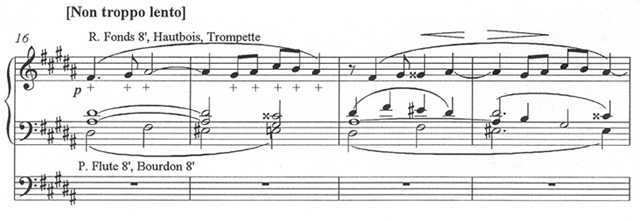
Demessieux may have previously been struck by the pitch similarity of Franck's theme with the first phrase of the hymn, rhythmically disguised though it is. Having decided to apply a form of Franck's short-short-long rhythm, for its affective quality, to the chant, she may have adopted Franck's title as a clue to the subtle link between the two compositions. An additional tie between the themes of the two pieces is similarity of registration: Franck's solo registration is Récit: Jeux de fonds de 8 pieds, Hautbois, Trompette; in comparable but less extravagant fashion, Demessieux's simply asks for Trompette 8' on the secondary manual. Of course, whereas for Franck's Cantabile the desired beauty and balance of registration serve an abstract musical quality, for Demessieux's Stabat Mater the associated text dictates that care be taken that the solo stop used, whether or not a Trompette is available, is suitably plangent rather than powerful.
The second piece that alludes to an earlier work by a French-romantic composer is the choral paraphrase based on the responsory Attende Domine. In creating what she termed a paraphrase of the chant, she may have had in mind Alexandre Guilmant's Paraphrase sur un Choeur de Judas Macchabée de Händel, "See, the conqu'ring hero comes!"19 Guilmant's piece begins with successive, verbatim renditions of the theme's two, eight-bar periods, but something closer to the notion of paraphrase occurs in the central section of the piece, a fugato. Its subject is the opening three measures of period one, cleverly imitated and counterpointed. The most striking moment of Guilmant's fugato, serving as preparation for a climactic retransition, is the introduction of the second period's opening motive in counterpoint above the fugue subject, which, as has been said, was derived from period one. The reprise, densely textured and mainly homophonic, also manages a degree of contrapuntal interplay between the first-period melody in the highest part and motives from period two in the bass.
Demessieux's choral paraphrase on Attende Domine, too, features counterpointing of motives from different phrases of the theme being paraphrased. After a richly figurated chromatic harmonization of the respond (in mm. 1-7), and a one-bar link derived from the melody of the versicle, the first of two sequentially modulating sections begins. It counterpoints successive entries of the opening of the respond with fragments of the melody for the versicles (see Ex. 2). The second modulatory section, mm. 19-33, is devoted to developing the opening motive of the versicle in a quasi-imitative texture, and to gradually introducing the subsidiary versicle motive that originally appeared as a link in m. 8. Finally, the reprise presents the complete versicle and respond melodies counterpointed, and begins with a short display of one of Demessieux's favourite contrapuntal techniques: canon in augmentation.
Example 2. Attende Domine. First of two modulating sections.
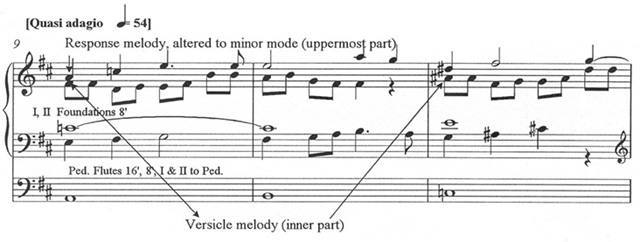
Canonic devices are prominent in Veni creator, but this piece, first and foremost, is an example of a French, moto perpetua toccata of a type invented by Widor in which "brief motifs from the chant are superimposed on motoric figuration."20 Demessieux allows the theme to permeate all parts of the texture. While one of its motives serves as an ostinato accompaniment figure, the chant theme enters in irregularly spaced, detached values at the top of the right-hand toccata figuration. As the second phrase of the theme enters in this way, the first phrase enters in imitation at the octave in a voice at the bottom of the left hand. The rhythm of the latter consists of sustained time values, evenly spaced and twice as long in duration. Later, at the opening of the reprise, both rhythmic versions of the chant begin together, and the slower of the two is imitated by an additional canonic voice a fifth below.
Just as Veni creator is not a Baroque toccata but a toccata in the nineteenth-century French manner, Vexilla regis is not a Baroque, but a Chopinesque, sort of prelude: a "sketch" of "picturesque or sentimental character," as Dupré refers to the nineteenth-century genre called prelude.21 Assuming that one knows the plainchant, the picture evoked in Vexilla regis is of a stately procession of subdued character: "The royal banners forward go: / The mystic Cross follows, / Where the One who gave life to our mortal flesh, / Died to preserve that life."
The chant melody is transformed into an E-minor Maestoso in quadruple time played by Flutes 8' and 4' in tenor register. Repeated and carefully articulated pedal notes suggest the beat of a bass drum, while the right-hand 8' foundations trace descending motions incorporating pathos-laden chromaticism. Particularly expressive are the harmonies that form cadential arrivals on the tonic triad. Part I closes at m. 7 with a grave Phrygian cadence upon an E-major triad. The piece ends with an emotion-laden progression from a common-tone French-sixth chord to an E-minor triad.
A well-known type of organ chorale cultivated by Bach, particularly admired by Dupré and Guilmant, and termed choral orné, is an Adagio that presents, with cornet or solo reed in the uppermost voice, the chorale melody adorned with rhetorically expressive melodic and rhythmic embellishments, while accompanying parts are played on a separate manual and pedal—as, for example, O Mensch, bewein dein Sünde gross from the Orgelbüchlein. Nevertheless, this is not the type of choral orné that Demesssieux's Rorate caeli represents. In Cours Complet d'Improvisation, Dupré cautions that the melodic embellishments compatible with the eighteenth-century style cannot be introduced into modern harmony without creating an unsatisfactory "pastiche."22 He therefore also describes a "modernized" form of choral orné. In this method, rather than adding rhythmic and melodic embellishments to the chorale, one takes its already existing and most pregnant contours, and applies to these melodic ideas successive, varying rhythmic interpretations chosen to heighten the already implied emotional content. "Each segment of the chorale phrase is to be studied; one must seek out the expressive value of each small fragment, whether stepwise or leap, ascending or descending. Symmetries, [linear] progressions, and especially the points of arrival of a melodic motion, which often carry the expressive emphasis, can be noted."23 In his textbook example of this type of choral orné, which is based on a German chorale, the following techniques may be observed.
(i) Durational and contour accents are used to establish regular metre.
(ii) Pitches are metrically shifted in comparison to their metrical context in the chorale.
(iii) A long duration is given to a particularly expressive pitch of the chorale, e.g., a pitch preceded by upward leap.
(iv) Anticipations are added, especially to pitches approached by step from above.
(v) A long, expressive pitch may be sustained into a metrically weak position so that, in comparison to the metric positions resulting from (iii), metric shift of the following pitches results.
(vi) Phrase beginnings are preceded by a short, strong-beat rest.
(vii) A variety of traditional types of varied repetition of a motive are gradually introduced.
In addition, Dupré cautions that, so as to avoid aimless wandering, the beginner must consciously count measures—in order to organize the continuous motivic development into phrases of regular length, and to organize phrases into a phrase group that is representative of a particular segment of the given melody.24
Demessieux's Rorate caeli is an exquisite instance of this type of choral orné. Its use of sections and fragments of the chant is detailed in Fig. 3.
Figure 3. Treatment of plainchant motives in Rorate caeli.
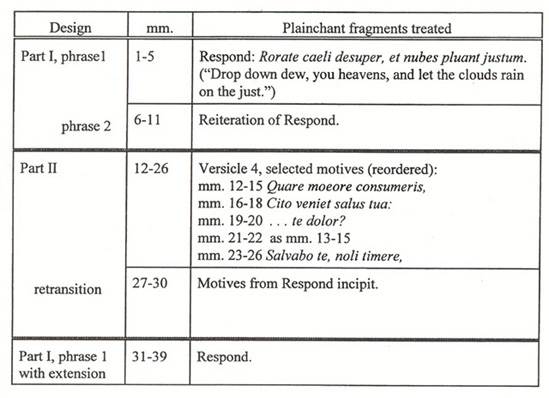
The respond is treated in mm. 1-11, first in a five-measure, then in a six-measure phrase. In the contrasting section, mm.12-26, motives from the reciting formula of the versicles (particularly those motives representative of phrases from versicle 4) are treated, but not in their original order.
Example 3 illustrates how the choral orné grows out of the chant. The reductive sketch at 3a draws attention to the distinction between three types of melodic element within the chant respond.
Example 3a. Linear reduction of plainchant respond Rorate caeli.

These are: the melody's underlying structural descent (stemmed notes), which begins on A4, is interrupted on G4 at the end of the first subphrase and, in the next subphrase, begins again on A4 and descends, stepwise to D4; elaboration of the initial A4 by a prefix ascending from F4, and a leap to D5 reconnected to A4 by step (notes that begin a slurred group, but are not stemmed); and other stepwise motives that expand the effect of a structural pitch by issuing from it (stemless noteheads following a stemmed note).
Example 3b is a transcription of the Liber Usualis notation of the respond, drawing attention to ornamental detail, particularly anticipations, and to the scale-wise third motive that participates in both the overall structural descent and its elaboration.
Example 3b. Motivic analysis of plainchant respond Rorate caeli.

Example 3c shows the organ piece's two versions of this melody in Part I.
Example 3c. Respond in organ piece. + marks metric change in mm. 6-11 as compared to mm. 1-5; a indicates melodic anticipation restored to mm. 6-11.

The first, mm. 1-5, establishes a regular metrical framework while applying durational accents to pitches that in the chant are ornamented by an anticipatory note or inflected by either an episima or a dot (the latter transcribed in Ex. 3b as a quarter note). In comparison to the metre established in mm.1-5, the second version, mm. 6-11, shifts some pitches (marked +) from weak to strong or vice versa, and reinstates an anticipation that was absent from the corresponding pitch in m. 2.
In contrast to Part I, Part II employs fragmentation of chant phrases, causing the varied repetitions of motives to be more closely spaced and Part II to have the greater rhythmic urgency. Example 3d compares some of these fragments.
Example 3d. Versicle 4 motives used in organ piece Rorate caeli.
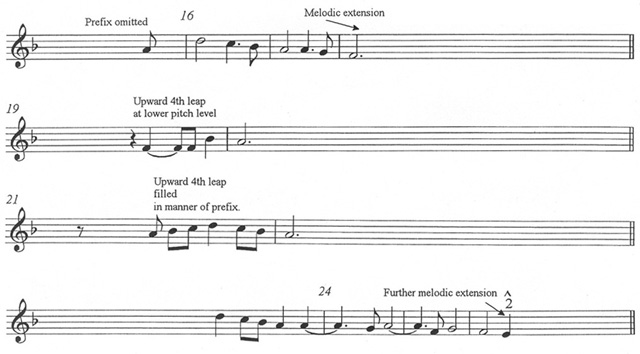
All of the motives are in shapes that link them to versicle 4 of the chant, yet, as indicated by the vertical alignment of excerpts in Ex. 3d with Ex. 3c, Part II also participates in the ongoing treatment of motives derived from the respond and established by Part I of the organ piece—in particular, the affective, upward fourth leap. Finally, Ex. 3e, from the restatement of Part I, shows how completion of Part II's process of melodic extension, together with rhythmic augmentation of the subphrase that originally occurred in mm. 3-5, creates closure for the piece as a whole.
Example 3e. Closing phrase of organ piece Rorate caeli.

Because it uses the simplest of textures idiomatic to the organ, Rorate caeli is the easiest of the Twelve to perform. Yet, it is not surprising that Demessieux selected it to play during her 1958 American recital tour.25 The compositional decisions made—to employ a process that appears to grow out of the nature of the chant, to present the metrical positions of melodic motives as flexible, and to arrange these successive treatments in subphrases, phrases, and larger groups of varying lengths so as to project the pacing of an overall pitch shape—play a large role in giving a texturally simple piece musical profundity.
Three of the Twelve are styled after character pieces without liturgical associations—genres such as Vierne included, or might have included, in his 24 Pièces en style libre—a march, a cradle song, and a shepherd's tune in the style of a musette. All three genres provide opportunities for word-specific tone painting. In the march, Tu es Petrus, the striking motive that begins the plainchant antiphon Tu es Petrus is employed in sequential repetition as an ostinato-like bass to represent the rock-solid foundation that is Peter's faith. The piece calls for a suitably marcato style of performance: beat-long rests distinguish the accompanying chords, which are coordinated with the plainchant motive in the bass, from another plainchant (belonging to the same text) heard in its entirety in the uppermost part.
The cradle-song characterization of the final piece of the set probably derives from the tendency of the opening phrases of Domine Jesu to oscillate between a fixed pitch and a pitch that is just a step below or third above (Ex. 4a).
Example 4a. Opening of plainchant.

Demessieux adds a gentle rhythmic sway that turns the oscillations into rocking motions, and specifies quiet 8' stops: flute in the pedal, and gamba (later, gamba and flute) for the manual parts (Ex. 4b).
Example 4b. Opening of Berceuse.
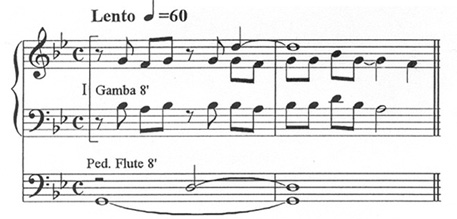
In association with the text, a prayer for the dead, the organ piece evokes a mood of comfort, for the dead and for those who mourn the dead.
Adeste fideles has the identifying drone base of a musette—a shepherd's piece for bagpipes. The wider repertoire alluded to here, one that has enjoyed a continuous history in French music beginning with the eighteenth century, is the organ noël, traditionally based upon an ancient French Christmas song. Although this setting is of an eighteenth-century, Latin song, it is reminiscent of the first organ noëls in its sparse, elegant texture, simple repetition of motives, and its counterpointing of distinct timbres, here open flute, gamba and 4' flute, and clarinet stops, reminiscent of rustic pipes and reed instruments. One must not, thereby, be unprepared for its twentieth-century harmonic idiom, including a surprise transposition on the first page, an amazing chromatic sequence at the turn from page 2 to page 3, and dissonant counterpoint throughout.
Generally speaking, the tradition of plainchant-based liturgical piece that found rebirth under Guilmant eschewed pictorial effects.26 Dupré, in his discussion of the suitability of variation procedure for a liturgical organ piece, advises that "the variation [form] has shed all of its picturesque character, except at Christmas time, when this manner of treatment is appropriate for simple, Medieval noëls."27 Demessieux extends this license to O filii et filiae, a metrical song of twelve stanzas, in a folk-like or ballad style, for Eastertide. For successive repetitions of the melody, she varies the accompaniment's texture and timbre, and its harmonic, motivic, and metric ideas, so as to give to each repetition representational qualities that follow very closely the text of the song.
The opening, monophonic presentation of the theme in tenor register forms a musical introduction, just as stanza one of the poem introduces the narrative subject, the story of how Jesus's disciples came to believe in his resurrection. Stanzas two and three of the poem begin the actual narration by telling of the women who come to the tomb early on the day after the Sabbath to embalm the body of Jesus. In a bold descriptive style, Demessieux's first variation transforms the melody in the style of a danse macabre, such as nineteenth-century composers adopted in reference to the gruesome Medieval myth that represents death as a dancing fiddler.
The poem continues as a merging of resurrection accounts in Luke and John: stanza four introduces the pair of angels who tell the women that the one they seek has gone ahead to Galilee (Luke 24:4-7), and stanza five tells of the arrival of Peter and John on the scene (John 20:2-9). Demessieux's second variation makes prominent use of continuous, eighth-note scales, repeatedly falling through three octaves of flute pipes. As rapid scales are a traditional way of describing angels descending from heaven, variation 2 would appear to be a reference to the poem's stanza four.28
The stanza derived from the Gospel of John does not appear to be represented, for the scene abruptly changes in the next variation. Variation 3, marked to be played at a slower tempo, is quiet and mysterious, creating the atmosphere of stanza 6, in which Jesus appears briefly to a group of the disciples in a locked room. As was mentioned earlier, this variation contains metric shift (Ex. 5).
Example 5. O filii. Metric shift in variation 3. Dotted bar lines show perceived points of metric accent.
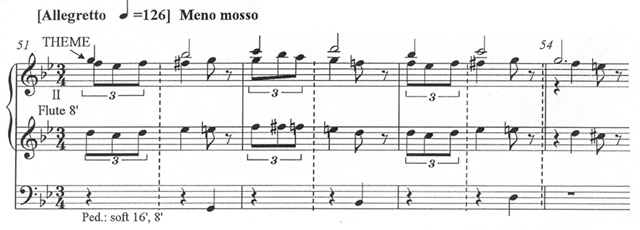
Unbeknownst to the listener, the rhythmic values for the first three bars of each phrase of the theme are notated one beat late. When, at the end of each phrase, the cadential pitch is abruptly synchronized with the notated metric accent—effectively robbing the phrase of a beat—the first-time listener will question what has apparently been heard, just as the disciples would have found it difficult to believe their eyes when they first saw the resurrected Christ.
Of course, as the poem's stanza 7 tells us, Thomas learns only later about this mysterious incident and refuses to believe it. The corresponding variation, at the original, Allegretto, tempo counterpoints the first eight measures of the theme with a metrical and motivic argument. The theme defines the metre. The argument is played by the left hand alternating between two versions of a dotted-rhythm motive, while jumping between the two manuals (Ex. 6a).
Example 6a. O filii, var. 4, with two versions of accompaniment motive.
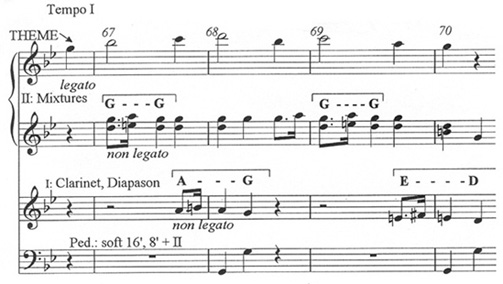
The first version (played on manual II, as is the theme) is, presumably, the disciples insisting on what they saw; this version of the dotted-rhythm motive aligns the beginning of the dotted-eighth-sixteenth group with the metric accent as defined by the theme. Abruptly, Thomas (the left hand on manual I) cuts in with a contradictory version of the motive, defiantly placing the note occurring immediately after the dotted rhythm with the metric accent (each metric accent further corroborated by entrance of the intermittent tonic pedal). Example 6a also draws attention to the difference in contour between Manual II (the disciples') and Manual I (Thomas's) version of the motive. Both contour and metric placement make Thomas's version sound more conclusive, hence more insistent, than the other. Musical tension is further heightened as, during the last eight measures of this variation, the bass line wrestles the harmony in the direction of C as pitch centre.
In stanza 8 of the poem, the resurrected Christ reappears to ask that Thomas observe his wounds. To represent this stanza, variation 5 of the organ piece follows at m. 83, with neither a break in continuity, nor resolution of the metrical argument. Instead, the mood of strife is increased by transformation of the theme to Lydian mode (four measures, in C), and widely spaced, harmonic ninths, sevenths, and seconds in the motivic accompaniment. Meanwhile, in the pedal, alternation of pitches that are well over an octave apart suggests the "leap of faith" required of the Christian.
The dotted-rhythm motive continues through variation 6, but only in what is apparently Thomas's insistent version. In stanza 9 of the poem, having seen the wounds in Jesus's side, feet, and hands, Thomas unequivocally declares "You are my God." The music's interpretation of this turning point in the story is complex (Ex. 6b).
Example 6b. O filii. Variation 6.
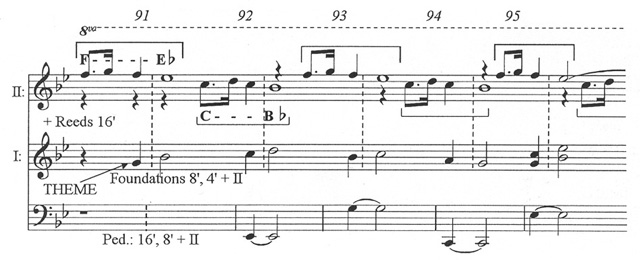
On the one hand, the metrical argument is resolved and the harmony retreats from the dissonance of variation 5. On the other hand, the O filii theme, in what will be its last statement, is metrically displaced in relation to what preceded it and in relation to the pedal part's motive. In relation to the theme (much more prominent than the pedal motive) the metrical placement of the dotted-rhythm motive is neither of its original, contradictory placements (cf. Ex. 6a).
The poem's remaining stanzas, in turn, emphasize the virtue of those who believe although they have not seen; express jubilation on the holy feast day; and pay the Christian's debt of humble thanks to God. The organ piece concludes, in mm. 99 ff., with a creative reconciliation of the issues surrounding the dotted-rhythm motive. As shown in Ex. 6c, the time values of the dotted rhythm are augmented.
Example 6c. O filii, beginning of closing section.
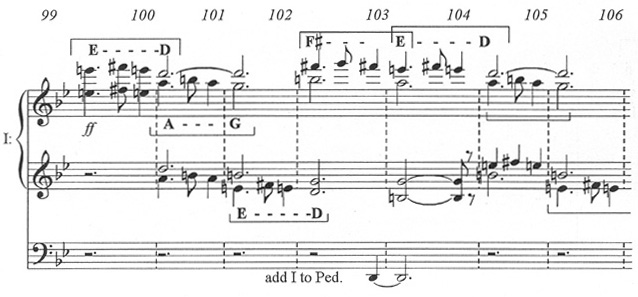
The motive here both begins and ends on what are effectively (although not notated) metrically strong beats, and retains the finality of the contour associated with Thomas's statements. To effect an affirmative harmonic close, in mm. 110-11 unambiguous dominant harmony progresses to a G-major tonic. Above the tonic pedal of the last five measures are chords in the reanimated dotted rhythm—Thomas's version—his formerly insistent unbelief redirected toward affirmation of faith. For a listener who knows the text of O filii, the variation set expresses the song's combination of simple, even child-like, story telling and serious profession of faith.
The piece left to be discussed, In manus tuas ("Into your hand, Lord, I commit my spirit; you have redeemed me, O Lord, faithful God." Ps. 31:5 RSV), is based upon an option for concluding Benediction, but has the curious subtitle Litanie. A litany, of course, is a supplicatory prayer consisting of a list of petitions or invocations and an unchanging response, all sung to the same simple, responsorial chant formula.29 Ex. 7a illustrates with an excerpt from the Litany of Loreto.
Example 7a. Litany of Loreto, excerpt.

The chant formulae consist of stepwise motion, third leaps, and repeated pitches, all confined to the range of a fourth. Litany as a composed, musical genre usually refers to a free setting of the text of a liturgical litany or of a litany-like text for voices and instruments. But more pertinent here is the well-known, short, organ piece by Jehan Alain, a mixed-meter, virtuoso toccata having the evocative title Litanies.30 Its theme, which in one form or another pervades the entire piece, consists of the typical melodic elements of a litany chant, repeated pitches, neighbor and other stepwise motions, and third leaps.
As may be seen from Ex. 7b, the responsorial chant In manus tuas also has a litany-like simplicity, and is very similar in spirit to portions of the Litany of Loreto.
Example 7b. Short responsory, In manus tuas.

Compare, for instance, the melodic cell in m. 1 of the versicle Redemisti nos Domine (Ex. 7b), with that in m. 3 of the Litany (Ex. 7a).31 Demessieux's organ setting of the responsorial chant allows its melodic simplicity, and some of its metrical subtlety, to predominate, as the slightly varied repetitions succeed each other (Ex. 7c).
Example 7c. Opening of In manus tuas (Litanie) by Demessieux.

At the same time, the piece's subtitle may be an ironic allusion to Alain's popular organ piece, for whereas his virtuosic Litanies is a loud cry, intense and rhythmically driven, the calmly repeated phrases of Demessieux's Litanie—in keeping with the notion of writing an instructional piece—are in simple metre at moderate tempo, forming a quietly insistent plea.
Of particular interest in Demessieux's piece is the control of pitch space from section to section (see Fig. 4).
Figure 4: In manus tuas: pattern of expansion and contraction of total ambitus in relation to melodic and tonal design. (Pedal notes represented by 16' registration when applicable.)
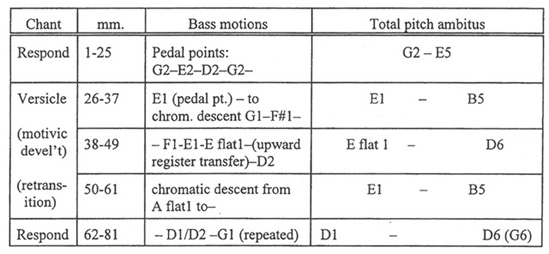
From the beginning through the climax at m. 43, as the piece becomes increasingly chromatic and its theme more fragmented, the upper and lower limits of pitch space gradually push outward. The retransition then consolidates materials within a narrower range in preparation for the reprise. The final statement of the respond gradually introduces the highest and lowest pitches of the organ piece in a quiet apotheosis of the chant.
This article began by suggesting that the importance of Demessieux's Twelve lies in its appropriateness for introducing organ students to the French post-romantic style early in their study. Used alongside technical exercises, and listening to and reading about the repertoire, such short, easy, and varied pieces will help the student solve many problems of technique and interpretation before he or she begins work on compositions by Langlais, Messiaen, and Alain, and on other compositions by Demessieux.
It has been demonstrated that although most of the genres and compositional styles among the Twelve are easily understood through reference to Dupré's Cours Complet d'Improvisation or to Vierne's type of character piece, some pieces unexpectedly mix a genre from an earlier era with a twentieth-century approach to harmony or plainchant rhythm, while the subtitles that are less obviously generic probably allude to specific, previously existing French organ compositions. Through careful study, these preludes can serve as an instructional tool for illustrating both fundamental premises and imaginative departures for plainchant-based organ music.
1Christiane Trieu-Colleney, Jeanne Demessieux: Une vie de luttes et gloire (Avignon: Les Presses Universelles, 1977); Karrin Ford, "Jeanne Demessieux," The American Organist 26 (April 1992): 58-64; Peggy Jane Johnson, "The Organ Compositions of Jeanne Demessieux (1921-1968)" (DMA thesis, University of Cincinnati, 1994); Jo Ewing Anderson, "The Organ Music of Jeanne Demessieux" (DMA document, University of Georgia, 1996).
2[Boston:] McLaughlin & Reilly, 1950; reissued by Summy-Birchard in 1995 and distributed by Warner Bros. According to Trieu-Colleney, the idea that Demessieux should write an organ work for publication in the United States grew out of Dupré's performances of her Six Études (composed 1944) during an American recital tour: audience praise for the astonishingly demanding Études included requests from American organists for another work by the newly popular composer, a work that, because they could not hear her perform, they could play for themselves. Trieu-Colleney, Une vie de luttes et gloire, 90.
3Trieu-Colleney, Une vie de luttes et gloire, 90. (All translations are by the author.)
4Programs from Demessieux's 1953, 1955, and 1958 recital tours are given in Laura Ellis, "The American Recital Tours of Jeanne Demessieux," The Diapason 10 (Oct. 1995): 14-18.
5Ronald Arnatt, "Jeanne Demessieux, Grant Memorial Chapel, Washington University, St. Louis, MO, February 10, 1958," The American Organist 41 (April 1958): 149. Quoted in Ellis, "The American Recital Tours," 16.
6Christian Goubault, Paris-Normandie (Oct. 15, 1979). Quoted in Pierre Labric and Michelle Leclerc, Programme Notes for Jeanne Demessieux, Orgelwerke (Motette CD 11671, 1991), 15.
7Benediction, in French Le Salut du Saint-Sacrement (In Honour of the Blessed Sacrament), is a Eucharistic devotion, at some times and in some locales observed either after Sunday Vespers or separately. "[T]he Blessed Sacrament is exposed, raised aloft, and the minister, tracing the Sign of the Cross with it, blesses the adorers." Jovian P. Lang, Dictionary of the Liturgy (New York: Catholic Book Publishing Co., 1989), 60. As part of the rite, customary hymns, litanies, antiphons, or responsories are sung. In an instruction book for student organists, Dupré outlined the sung portions of the rite as follows: (1) a chant in honour of the Blessed Sacrament; (1a) one of the seasonal chants prescribed for Benediction, if and as appropriate; (2) a chant in honour of the Blessed Virgin Mary; (3) an antiphon for the Pope; (3a) Te Deum laudamus; (4) Tantum ergo (precedes the sign of the cross); (5) Laudate Dominum (after the sign of the cross). Marcel Dupré, Manuel d'Accompagnement du Plain Chant Grégorien (Paris: Leduc, [1936]), 46-47. A more complete index of chants appropriate to these categories may be found in The Liber Usualis with Introduction and Rubrics in English, ed. by the Benedictines of Solesmes (Tournai, Belgium: Desclée & Co., 1956), Appendix II, pp. 93* -95* [sic].
8A former student of, and assistant to, Demessieux as professor of organ at the Royal Conservatory in Liège, Belgium, Jean Wolfs, has confirmed that where Demessieux specified registrations and metronome marks, she expected them to be adapted to the instrument and the acoustics of the room. Johnson, The Organ Compositions, 111, 117.
9Pierre Denis, "Les Organistes Français d'aujourd'hui: XVI. Jeanne Demessieux," L'Orgue No. 75 (1955): 40.
10According to Stephen Bicknell, the essential elements of the French registration called foundations are the Montre 8', Flute Harmonique 8', and Bourdon 8', pipes that Cavaillé-Coll made to his own specifications. "Cavaillé-Coll was obsessed with melodic strength . . . In the fonds the abiding impression is of a gentle, unfocussed but full bass with a very strong melodic impetus in the treble." Stephen Bicknell, posting to Pipe Organ List, 1997.
11Alexandre Guilmant (1837-1911), one of Dupré's principal teachers, is thought to be the first French organist-composer to demonstrate use of the timbral resources of the organ in conveying the meaning of a chant text. Edward Zimmerman and Lawrence Archbold, "Guilmant's L'Organiste Liturgiste," in French Organ Music from the Revolution to Franck and Widor, ed. Lawrence Archbold and William J. Peterson (Rochester: University of Rochester Press, 1995), 219-20. Use of registration as a text-painting device in French liturgical organ music represented a marked departure from the French-classical practice of associating registration primarily with genre and texture.
12The improvisational forms that Dupré taught are outlined in his Traité d'Improvisation à l'Orgue (Paris: Leduc [1926]), also published as vol. 2 of Cours Complet d'Improvisation à l'Orgue (Paris: Leduc [1936]). The French-classical influence on Dupré came doubtless via Guilmant, who edited the organ music of sixteenth- through eighteenth-century French composers for modern publication around the turn of the twentieth century. Dupré's enthusiasm for Bach's compositional forms is a reflection of his training under both Guilmant and Charles-Marie Widor (1844-1937).
13Paris, 1623. The sixteen short pieces of Dupré's Le Tombeau de Titelouze include eight based upon plainchant hymns that Titelouze included in Hymnes de l'Eglise.
14William James Dorroh, "A Study of Plainsong in the Organ Compositions of Six Twentieth Century French Composers" (PhD diss., George Peabody College for Teachers, 1978), 9.
15Ellis, "The American Recital Tours," 14-15.
16See David Ponsford, "J. S. Bach and the Nature of French 'Influence,'" The Organ Yearbook, vol. 29: Bach and the Organ, ed. Peter Williams and Michael Heinemann (Laaber: Laaber Verlag, 2000), 65. The organ works of Nicolas de Grigny (c.1672-1703) are exceptional among those of the French classical school for the important role given to the pedals, for the frequency with which he chose a five-part texture (with pedal cantus firmus acting as harmonic support and the upper parts engaging in free imitation), for the consistency with which he maintained the number of parts in a texture, for his imaginative modulations and chromaticism, for logical development, and for depth of feeling. James R. Anthony, French Baroque Music from Beaujoyeulx to Rameau, rev. ed. (New York: Norton, 1978), 282-83. Almonte Howell and François Sabatier, "Grigny, Nicolas de," New Grove Dictionary, 2d. ed., vol. 10, p. 417.
17Dupré, Cours Complet d'Improvisation, vol. 2, 53. As models of the genre, Dupré cites chorale fugues by Bach. Presumably, though, Dupré was familiar with Grigny's as well as Bach's chorale fugues, for Guilmant had edited Grigny's organ music for Archives des maîtres de l'orgue, vol. IV (Paris, 1904). An example of a five-part fugue by Dupré containing an exposition on each phrase of a plainchant, with each pedal entrance occurring last in rhythmic augmentation, is No. 15 from Le Tombeau de Titelouze, based on the hymn Te splendor et virtus Patris (LU, p. 1661).
18Trieu-Colleney notes a similarity between the character of the chromaticism in this Adagio and that of the Adagio movement of Demessieux's Triptyque for organ, also composed in 1947 (Paris: Durand [1949]). Trieu-Colleney, Une vie de luttes et de gloire, 91.
19Alexandre Guilmant, Paraphrase sur un Chur de Judas Macchabée de Händel from 18 Pièces Nouvelles, op. 90, in The Organ Music of Alexandre Guilmant , vol. IV, ed. Wayne Leupold (Melville, N. Y.: Belwin-Mills, 1984; [originally published Paris: A. Guilmant, 1904]), 57-61.
20Benjamin Van Wye, "Marcel Dupré's Marian Vespers and the French alternatim Tradition," The Music Review 43 (1982): 220.
21Dupré, Cours Complet d'Improvisation, vol. 2, 66.
22Cours Complet d'Improvisation, vol. 2, 52.
23Ibid., 53.
24Ibid. A complete, short, example of this type of choral orné, based upon plainchant and composed by Dupré, is Alma redemptoris Mater, no. 5 in Eight Short Preludes on Gregorian Themes for Organ, op. 45 (Miami, Fla.: Warner Bros., distributors for Summy-Birchard, 1998; [originally published by McLaughlin & Reilly, 1958]), 12.
25Ellis, "The American Recital Tours," 16.
26Guilmant, although approving of text painting in the manner of Bach, eschewed all gratuitous, pictorial effects. Zimmerman and Archbold, "Guilmant's L'Organiste Liturgiste," 218-19. These authors hypothesize that Guilmant was loathe to stir up remembrance of the tasteless, pictorial improvisations that earlier nineteenth-century French organists had made popular. For reference to organ improvisations depicting scenes of battle, the "Last Judgement," and storms, see Orpha Ochse, Organists and Organ Playing in Nineteenth-Century France and Belgium (Bloomington: Indiana University Press, 1994), 5-7, 14-15, 48-49.
27Dupré, Cours Complet d'Improvisation, vol. 2, 134.
28A well-known precedent for this musical signifier occurs in Bach's Vom Himmel kam der Engel schar (BVW 607), Orgelbüchlein, no. 9.
29A very early, Gallican form of litany of the Middle Ages consisted of psalm verses, each divided as versicle and response (New Grove Dictionary, 2d ed., vol. 12, 880).
30Jehan Alain (1911-40), Litanies, op. 119 (Paris: Leduc, 1938).
31The chant In manus tuas is of the type called short responsory. A short responsory has only one, short versicle (other than a concluding Gloria Patri), its text being a single psalm verse, the first half of the psalm verse serving as the respond and the second as the versicle of the responsory. (In this respect, the text of a short responsory is similar to use of a Psalm text in the early Gallican litany described in n. 29.) The restatement of the respond following the versicle is shortened, making it only about as long as the response of a litany. The chants of all short responsories have in common a small set of melodic formulae.


